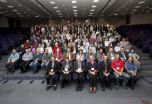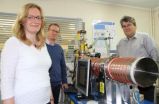(Press-News.org) The week-long discussions and decisions of the Nomenclature Section of the XVIII International Botanical Congress took place in Melbourne, Australia in July 2011. This meeting is held every six years and it is where the world's premier experts on the rules for naming algae, fungi and plants get together to debate and update the rule book for naming the organisms they study. This is the primary product of the meeting, the International Code of Nomenclature for algae, fungi, and plants, which was published in 2012. The other important product is the official report for the historical record, which has just been published as an open-access forum paper in PhytoKeys.
Several significant decisions were made at this meeting, most visibly the change of the title of the rules of nomenclature from the International Code of Botanical Nomenclature – which implies it applies only to plants – to the International Code of Nomenclature for algae, fungi, and plants – which accurately reflects its scope. This change had been particularly desired by mycologists, the scientists who study fungi.
There were other major changes, foremost among them the possibility to publish new names of algae, fungi, and plants in electronic form only. This means that printed copies, which had previously been mandatory, are no longer required. Another break with tradition was to allow English to be used as an alternative to Latin when publishing formal descriptions of organisms new to science. Previously only Latin could be used.
Co-author Nicholas Turland said "Permitting electronic-only publication was arguably the most important decision made in Melbourne, bringing taxonomy into the 21st century and the electronic age. As for Latin, it has become increasingly difficult to use and is often regarded as an irrelevant anachronism by modern scientists. The meeting clearly wanted an alternative."
The report was co-authored by Christina Flann, Species 2000, Naturalis Biodiversity Center, Leiden, The Netherlands; Nicholas J. Turland, Botanic Garden and Botanical Museum Berlin-Dahlem, Germany; and Anna M. Monro, Centre for Australian National Biodiversity Research, Canberra, Australia. Production of the report was supported by funds from the International Association for Plant taxonomy (IAPT; http://www.iapt-taxon.org/index_layer.php), while its publication as an open-access forum paper was sponsored by Pensoft.
The meeting in Melbourne was well attended, especially in view of the distances many people had to travel. There were 204 delegates representing 56 countries. The geographical composition was uneven with a predictably high number from Australia (about one-third) and about as many from other Anglophone countries.
Co-author Christina Flann said "The much lower African, Asian, and Central and South American presence is far from ideal. These inequalities have deep historical roots and are compounded by uneven access to funding to attend the meeting." She went on to note "On this occasion there was a strong female presence in leadership positions, despite the ratio of delegates still being skewed toward the male side; about one-third were women. Dr. Sandra Knapp, from the Natural History Museum, London, did an exemplary job in the role of President of the meeting."
INFORMATION:
Original Source:
Flann C, Turland N, M. Monro A (2014) Report on botanical nomenclature—Melbourne 2011 XVIII International Botanical Congress, Melbourne: Nomenclature Section, 18-22 July 2011. PhytoKeys 41: 1-289. doi: 10.3897/phytokeys.41.8398
Week-long meeting on naming algae, fungi, and plants recorded for posterity
2014-09-01
ELSE PRESS RELEASES FROM THIS DATE:
Scientists get set for simulated nuclear inspection
2014-09-01
Some 40 scientists and technicians from around the world will descend on Jordan in November to take part in a simulated on-site inspection of a suspected nuclear test site on the banks of the Dead Sea.
Playing the part of inspectors, the experts will have access to a wide range of sensor technologies to look for signs of whether a nuclear explosion has taken place. At the same time, other role-players representing the state under inspection will try to put them off their scent.
The aim of this elaborate exercise, as science writer Edwin Cartlidge explains in this month's ...
Invisible blood in urine may indicate bladder cancer
2014-09-01
New research which finds that invisible blood in urine may be an early warning sign of bladder cancer is likely to shape guidelines for clinicians.
Scientists at the University of Exeter Medical School found that one in 60 people over the age of 60 who had invisible blood in their urine (identified by their GP testing their urine) transpired to have bladder cancer. The figure was around half those who had visible blood in their urine – the best known indicator of bladder cancer. However, it was still higher than figures for other potential symptoms of bladder cancer ...
Sugar substance 'kills' good HDL cholesterol, new research finds
2014-09-01
Scientists at the University of Warwick have discovered that 'good' cholesterol is turned 'bad' by a sugar-derived substance.
The substance, methylglyoxal - MG, was found to damage 'good' HDL cholesterol, which removes excess levels of bad cholesterol from the body.
Low levels of HDL, High Density Lipoprotein, are closely linked to heart disease, with increased levels of MG being common in the elderly and those with diabetes or kidney problems.
Supported by funding from the British Heart Foundation (BHF) and published in Nutrition and Diabetes, the researchers ...
New tuberculosis blood test in children is reliable and highly specific
2014-09-01
A new blood test provides a fast and accurate tool to diagnose tuberculosis in children, a new proof-of-concept study shows. The newly developed test (TAM-TB assay) is the first reliable immunodiagnostic assay to detect active tuberculosis in children. The test features excellent specificity, a similar sensitivity as culture tests in combination with speed of a blood test. The promising findings are a major advance for the diagnosis of tuberculosis in children, particularly in tuberculosis-endemic regions.
The study has been published on Sept 1st, 2014 in Lancet Infectious ...
Scientists develop 'electronic nose' for rapid detection of C. diff infection
2014-09-01
A fast-sensitive "electronic-nose" for sniffing the highly infectious bacteria C. diff, that causes diarrhoea, temperature and stomach cramps, has been developed by a team at the University of Leicester.
Using a mass spectrometer, the research team has demonstrated that it is possible to identify the unique 'smell' of C. diff which would lead to rapid diagnosis of the condition.
What is more, the Leicester team say it could be possible to identify different strains of the disease simply from their smell – a chemical fingerprint - helping medics to target the particular ...
Why plants in the office make us more productive
2014-09-01
'Green' offices with plants make staff happier and more productive than 'lean' designs stripped of greenery, new research shows.
In the first field study of its kind, published today, researchers found enriching a 'lean' office with plants could increase productivity by 15%.
The team examined the impact of 'lean' and 'green' offices on staff's perceptions of air quality, concentration, and workplace satisfaction, and monitored productivity levels over subsequent months in two large commercial offices in the UK and The Netherlands.
Lead researcher Marlon Nieuwenhuis, ...
Doctor revalidation needs to address 7 key issues for success, claims report
2014-09-01
New research launched today, 1st September 2014, has concluded that there are seven key issues that need to be addressed to ensure the future success of doctor revalidation, the most profound revision in medical regulation since the Medical Act of 1858.
The research has been funded by the Health Foundation, an independent health care charity, as part of a long-term programme looking at different aspects of revalidation. The work has been carried out by academics at the Collaboration for the Advancement of Medical Education, Research and Assessment (CAMERA) at Plymouth ...
Memory in silent neurons
2014-08-31
When we learn, we associate a sensory experience either with other stimuli or with a certain type of behaviour. The neurons in the cerebral cortex that transmit the information modify the synaptic connections that they have with the other neurons. According to a generally-accepted model of synaptic plasticity, a neuron that communicates with others of the same kind emits an electrical impulse as well as activating its synapses transiently. This electrical pulse, combined with the signal received from other neurons, acts to stimulate the synapses. How is it that some neurons ...
A new synthetic amino acid for an emerging class of drugs
2014-08-31
One of the greatest challenges in modern medicine is developing drugs that are highly effective against a target, but with minimal toxicity and side-effects to the patient. Such properties are directly related to the 3D structure of the drug molecule. Ideally, the drug should have a shape that is perfectly complementary to a disease-causing target, so that it binds it with high specificity. Publishing in Nature Chemistry, EPFL scientists have developed a synthetic amino acid that can impact the 3D structure of bioactive peptides and enhance their potency.
Peptides and ...
Discovery reveals how bacteria distinguish harmful vs. helpful viruses
2014-08-31
When they are not busy attacking us, germs go after each other. But when viruses invade bacteria, it doesn't always spell disaster for the infected microbes: Sometimes viruses actually carry helpful genes that a bacterium can harness to, say, expand its diet or better attack its own hosts.
Scientists have assumed the bacterial version of an immune system would robotically destroy anything it recognized as invading viral genes. However, new experiments at Rockefeller University have now revealed that one variety of the bacterial immune system known as the CRISPR-Cas system ...



